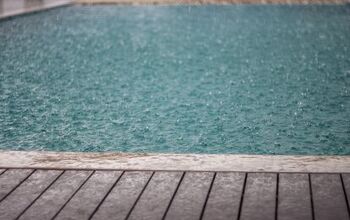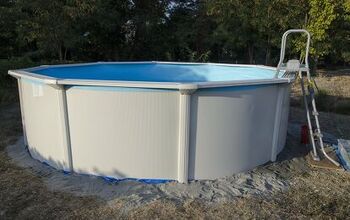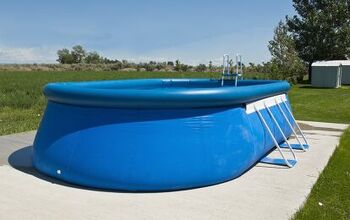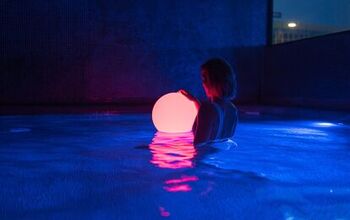Can You Put A Pool Under Power Lines? (Find Out Now!)

Pools and spas are, in my opinion, some of the best outdoor fixtures that a home can include. But without electricity, these fixtures wouldn’t be the wonderful luxuries we know today, as many of their features require electricity. Pumps, lights, and heaters are all pool components that require electricity.
These electrical fixtures must be installed in accordance with your area’s electric code, and most homeowners get a licensed electrician to install these fixtures. In this article, several code requirements from the National Electric Code (NEC) are listed and explained. While the codes in your area may not mirror these word for word, it’s quite likely they’re very similar.
One code-related question that pool owners often ask has to do with overhead power lines. Specifically, pool owners want to know everything there is to know about overhead power lines as they relate to pools. This article will give you just that!
A pool can be installed under power lines if certain code requirements are satisfied, but installing a pool under power lines is not recommended. If water makes contact with the lines, such could create a dangerous situation. Similarly, the lines could be tapped midst straining. Lines could also come down and into the pool during a bad storm.
Do You a Need Pool, Spa, or Hot Tub Contractor?
Get free, zero-commitment quotes from pro contractors near you.

Importance of Electrical Safety Around the Pool
You must ensure the area around your pool/spa is safe, and you can start by making sure all the electrical components are installed and functioning properly. Since there’s so much water in and around the pool, it’s vital to ensure there are no loose or frayed wires, and all electrical components must be presenting no issues.
Say, for example, a wire in the filter gets worn down after years of use. If this wire manages to get exposed to the larger body of water, electrical currents will flow throughout the pool, turning it into a deadly shock pit.
For this reason, it’s best to avoid DIY electrical work and instead hire a professional electrician. You can even hire an electrician who specializes in pools and spas, and they will ensure your pool/spa is equipped with all the appliances and features it’ll need to be a wonderful backyard sanctuary.
How Overhead Power Lines Affect a Pool Installation
Before you install a swimming pool or spa in your backyard, you need to understand how the pool installation is affected by the overhead power lines that run across your property (if there are any).
Utility Power Lines & Communication Cables
If there are utility power lines running over the space where you intend to put a pool or spa, you must ensure that there is at least 22.5 feet between the water level and the lines. The lines must also be the same distance from any diving platforms
Communication cables, on the other hand, only need to be 10 feet above the water level, and 10 feet above any diving platforms as well.
Note: Water level, according to the NEC, is the highest point water reaches before it overflows out of the pool or spa.
What Most Homeowners Do
Although it’s permissible to have a pool or spa under power lines, most homeowners opt to install their water-based fixtures a considerable distance away from any power lines. After all, water isn’t the only thing you would have to worry about coming into contact with the power lines. If you are straining the pool using a long, metallic net, this tool may come into contact with the power lines, and if this happens it’s likely you’d be electrocuted.
Moreover, if wires are blown down in a bad storm, they may land in the pool/spa if the fixture is directly under them. If this were to happen, it would create an extremely hazardous situation, one that would need immediate remedying from the fire department and/or local electric company.
Ensure These Other Electrical Components Are Functioning Properly
Underground Wiring
You can utilize underground wiring when you need to power your pool. Just ensure that all wires are at least 5 feet away from any of the pool’s sides. Also, underground wiring can’t go directly under a pool or spa.
There are exceptions, however, for lighting and other electrical components that pools and spas sometimes utilize. If it’s impossible to keep the wires 5 feet from the wall, one way to safely get the wires closer is to install a complete raceway (conduit) system.
Just keep in mind that a rigid metal raceway (RMC) requires at least 6 inches of overhead space. If you’re using a non-metallic raceway, there must be 6 inches of overhead space, and 4 of these inches must be concrete. If you’re not using a concrete encasement, the non-metallic conduit has to be 18 inches below the surface.
Electrical Outlets
Electrical outlets to which pumps and motors are connected must be at least 6 feet away from all pool walls, and they must be locked and protected by ground-fault circuit interrupters (GFCI). An outlet that’s for general use—and not protected by a GFCI—should be at least 20 feet away from the pool or spa, whereas an outlet that’s protected by a GFCI should be at least 6 feet away from the pool/spa.
If you have an in-ground pool, you’ll need at least one GFCI-protected outlet nearby, and this should be at least 6 feet away from the edge of the pool, but it can be as far away as 20 feet.
Do You a Need Pool, Spa, or Hot Tub Contractor?
Get free, zero-commitment quotes from pro contractors near you.

GFCIs
Ground-fault circuit interrupters are devices that protect pools and spas from rogue electric currents. Even if these aren’t required by code, you should install them to ensure maximum safety. Below are the electric components that should be protected by GFCI’s
- Convenience outlets
- Underwater pool lights (15 volts or more)
- Motors and controls for pool covers
- Exterior lights
Maintenance Disconnect
You’ll also need to install a maintenance disconnect, and this fixture will shut down power to the pool’s electrical components, mainly the pumps, filters, and lights. The disconnect must be somewhat close to the pool, but it has to be at least 5 feet away. In other words, reaching out of the water shouldn’t allow you to turn the power on or off.

Matt loves everything DIY. He has been learning and practicing different trades since he was a kid, and he's often the first one called when a friend or family member needs a helping hand at home. Matt loves to work with wood and stone, and landscaping is by far his most favorite pastime.
More by Matthew Mountain



























